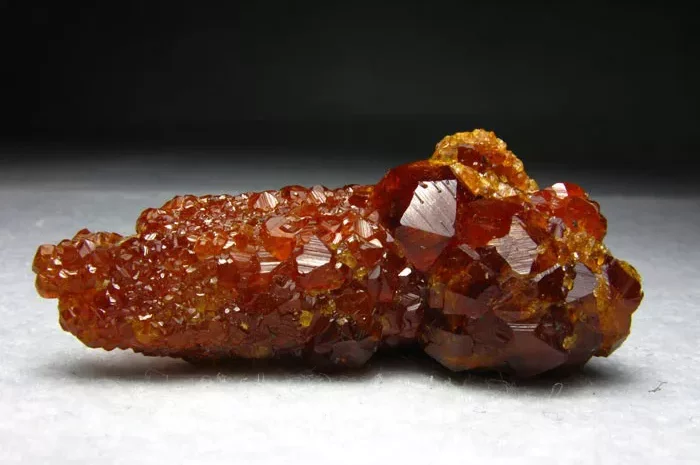Grossular garnet, a member of the garnet family, is a fascinating gemstone known for its diverse range of colors and unique properties. Often found in shades of green, yellow, and orange, grossular garnet is a favorite among gem enthusiasts and jewelers alike. Identifying a genuine grossular garnet requires a combination of observational skills and scientific techniques. This article will guide you through the process of distinguishing a genuine grossular garnet from imitations and other garnet varieties.
Understanding Grossular Garnet
What is Grossular Garnet?
Grossular garnet is a calcium-aluminum silicate mineral, with the chemical formula Ca₃Al₂(SiO₄)₃. It is part of the garnet group, which includes several other minerals such as almandine, pyrope, and spessartine. Grossular garnet’s name is derived from the botanical term “grossularia,” referring to the gooseberry, due to its green variety resembling the fruit.
Color Variations
Grossular garnet is known for its wide spectrum of colors:
Green: Known as tsavorite, this is the most prized variety.
Yellow: Sometimes called hessonite or cinnamon stone.
Orange to Red: These shades are also found but are less common.
Colorless: Rare and often less valuable.
Physical Properties
Hardness: Grossular garnet has a hardness of 6.5 to 7.5 on the Mohs scale, making it suitable for various types of jewelry.
Refractive Index: It has a refractive index ranging from 1.734 to 1.759.
Specific Gravity: The specific gravity of grossular garnet ranges from 3.57 to 3.73.
Identifying Genuine Grossular Garnet
Visual Inspection
Color and Clarity
Start by examining the color and clarity of the gemstone:
Consistent Color: Genuine grossular garnet typically exhibits a consistent and vivid color without zoning.
Inclusions: Natural inclusions, such as mineral crystals or needles, can be present. Use a loupe or microscope to look for these inclusions, as they can be indicative of a genuine stone.
Surface Inspection
Inspect the surface of the gemstone for any signs of wear or damage:
Luster: Grossular garnet has a vitreous (glassy) luster. A dull or waxy luster might indicate a synthetic or treated stone.
Scratches and Chips: Check for scratches or chips, especially if the gemstone is supposed to be new. Garnets are relatively hard, so significant surface damage could be a red flag.
Use of Instruments
Refractometer
A refractometer can help determine the refractive index of the gemstone. Grossular garnet has a refractive index ranging from 1.734 to 1.759. If the measured refractive index falls outside this range, the stone might not be grossular garnet.
Specific Gravity Measurement
Determining the specific gravity of the gemstone can provide further confirmation. Grossular garnet’s specific gravity ranges from 3.57 to 3.73. This test can be performed using a hydrostatic balance.
Spectroscope
A spectroscope can be used to analyze the gemstone’s absorption spectrum. Grossular garnet typically shows absorption lines in the red and green regions of the spectrum. Identifying these characteristic lines can help confirm the gemstone’s identity.
Advanced Testing
X-ray Diffraction (XRD)
X-ray diffraction can be used to determine the crystalline structure of the gemstone. Grossular garnet has a specific crystalline structure that can be identified using XRD. This method is highly accurate but usually requires access to specialized laboratory equipment.
Infrared Spectroscopy (FTIR)
Fourier-transform infrared spectroscopy (FTIR) can be used to analyze the chemical composition of the gemstone. This method can detect specific molecular bonds that are characteristic of grossular garnet.
Differentiating Grossular Garnet from Other Garnets
Pyrope Garnet
Color: Typically deep red.
Refractive Index: Lower than grossular, around 1.72 to 1.74.
Specific Gravity: Slightly higher, ranging from 3.77 to 3.95.
Almandine Garnet
Color: Ranges from red to reddish-brown.
Refractive Index: Higher than grossular, around 1.75 to 1.83.
Specific Gravity: Higher, ranging from 3.93 to 4.30.
Spessartine Garnet
Color: Usually orange to reddish-orange.
Refractive Index: Similar to grossular, around 1.79 to 1.81.
Specific Gravity: Higher, ranging from 4.12 to 4.32.
Common Imitations and Enhancements
Glass Imitations
Glass can be dyed to mimic the appearance of grossular garnet. Glass imitations are usually easy to identify due to their lower hardness and lack of natural inclusions. Glass has a lower refractive index (around 1.50 to 1.70) and specific gravity (around 2.50 to 4.00) compared to grossular garnet.
Synthetic Garnets
Synthetic garnets are created in laboratories and can closely resemble natural grossular garnet. These can be identified through advanced testing methods such as spectroscopy and X-ray diffraction. Synthetic garnets often lack the natural inclusions found in genuine stones.
Color Enhancements
Some grossular garnets undergo treatments to enhance their color. These treatments can include heat treatment or diffusion. Identifying treated stones can be challenging and often requires laboratory analysis. However, telltale signs of treatment, such as unnatural color zoning or surface residues, can sometimes be observed.
See Also: What is a Raspberry Rhodolite?
Caring for Grossular Garnet
Cleaning
To maintain the brilliance of your grossular garnet, clean it regularly:
Mild Soap and Water: Use a mild soap solution and a soft brush to clean the gemstone.
Avoid Harsh Chemicals: Harsh chemicals can damage the surface of the gemstone.
Ultrasonic Cleaners: Generally safe for grossular garnet, but avoid if the stone has significant inclusions or fractures.
Storage
Proper storage is essential to prevent damage:
Separate Compartments: Store grossular garnets separately from other gemstones to prevent scratches.
Soft Cloth: Wrap the gemstone in a soft cloth before placing it in a jewelry box.
Regular Inspections
Regularly inspect your grossular garnet jewelry for signs of wear and tear. Check for loose settings, scratches, or chips. Early detection can prevent further damage.
Conclusion
Identifying a genuine grossular garnet requires a combination of visual inspection, instrumental analysis, and sometimes advanced laboratory testing. By understanding the physical properties and common characteristics of grossular garnet, you can better distinguish it from imitations and other garnet varieties. Proper care and maintenance will ensure that your grossular garnet retains its beauty and value for years to come.
Whether you are a gem enthusiast, a jeweler, or simply someone who appreciates the beauty of gemstones, these guidelines will help you confidently identify and care for genuine grossular garnet.


